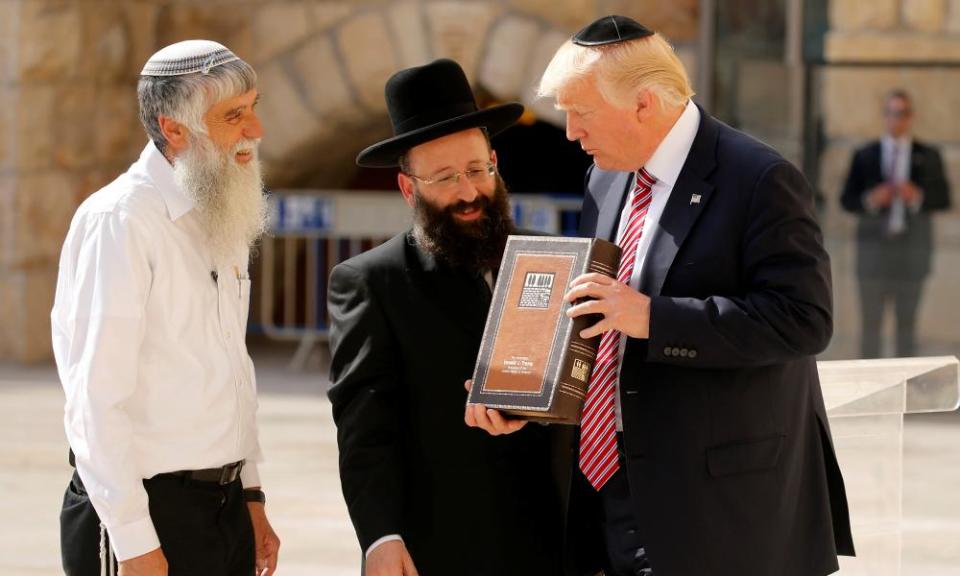The Chosen Wars review: study of American Jews reveals familiar schisms
Steven Weisman finds ‘contention and dispute’ at every stage of Jewish American history – including modern-day politics

On election day 2016, Hillary Clinton won more than 70% of the Jewish vote. But that number tells only part of a story. In some predominately Orthodox Jewish precincts, Donald Trump’s numbers were straight out of the rust belt or the deep south.
As in the rest of the electorate, religious commitment and educational attainment shaped how Jews voted. In the overwhelmingly religious Borough Park neighborhood of Brooklyn, Trump took 68% of the vote. In New Jersey’s Lakewood Township, he won with a 50-point margin. By contrast, the island of Manhattan was a sea of Democratic blue.
The political cleavages that mark the broader American landscape exist among America’s Jews. Just as Jews were to be found on both sides of slavery, secession and the civil war, they are again combatants in a political skirmish. Think of Jared Kushner, the president’s son-in-law, and Chuck Schumer, the Senate minority leader.
Welcome to The Chosen Wars, a narrative of the Jewish journey across the American landscape. Steven Weisman, who covered politics and economics at the New York Times for a quarter of a century, marshals an impressive array of facts to argue that the competing tugs of separatism and assimilation have been present ever since Jews landed in the New World in the 17th century, that even among the devout the broader culture affected religious practice, and that Jewish communal engagement has ebbed and flowed with time.
As Weisman frames things, “Jewish belief in the Jewish people’s own unique identity … has been so strong that it remains a foundation of Jewish life in the United States.” He also acknowledges that identity “has always been and will likely be one of contention and dispute”. Things are alloyed.
The book chronicles how the constitution’s establishment clause led to the laity’s supremacy within the synagogue. Most notably for Weisman, a schism within a Charleston shul triggered a landmark lawsuit and decision. Unlike Europe, the civil authorities would not pick sides even when asked. Ultimately, a South Carolina appellate court ruled in 1846 that the judiciary must avoid “questions of theological doctrine, depending on speculative faith, or ecclesiastical rites”.
In other words, they would let the Jews duke it out among themselves.
At times they really did. Weisman describes an actual riot that broke out on Rosh Hashanah 1850 in Albany, New York, over the nature of the Messiah. The police were called and the congregation dispersed, but not before the synagogue president taunted the rabbi, Isaac Wise, saying: “I have $100,000 more than you.” Yet it was Wise’s rejection of a personal and national Messiah that shaped Reform Judaism. It represented a break from 2,000 years of tradition.
The book also examines how Darwin and criticism impacted attitudes toward the Bible, divine authorship taking a hit. Emil Hirsch, a Reform Rabbi and professor at the University of Chicago, declared: “Modern scholarship has spoken, and its voice cannot be hushed.”
To put things in context, even those more traditionally minded were forced to respond or adjust to science.
On the one hand, within the Hasidic movement the dominant mantra remains: “If you are still troubled by the theory of evolution, I can tell you without fear of contradiction that it has not a shred of evidence to support it.”
On the other, within Orthodoxy’s more modern circles there was a retreat from taking the creation story and Genesis’s timeline literally. A “day” came to be read as eons, and the Divine Hand could be found guiding the Descent of Man.
Said differently, distinctions are now being drawn between the “historical credibility of biblical narrative” and its “theological truths”.

Weisman gives Orthodoxy its due as a force to be reckoned with. From Long Island’s Five Towns to the Upper East Side, and in the Young Israel of New Rochelle and Scarsdale, the denomination is no longer acting like a poor relation.
The Chosen Wars occasionally loses sight of relevant skirmishes within American Protestantism. Weisman does a deep dive on the battle waged from the pulpit on slavery and secession but makes no reference to its antecedents. In a sense, 19th-century Jews arrived late to that party.
In 1700 Samuel Sewall, a Massachusetts businessman and magistrate, penned The Selling of Joseph, which served as a theological rebuttal to the contention that blacks were inferior in the eyes of God, and that their plight as slaves was preordained as the purported descendants of Ham and Canaan, Noah’s cursed son and grandson.
Sewall, a judge during the Salem witchcraft trials, contended that “Joseph was rightfully no more a Slave to his Brethren, than they were to him: and they had no more Authority to Sell him, than they had to Slay him”. Against that backdrop, the “Curse of Ham”, invoked in a New York synagogue in the run-up to the civil war, sounds like a recapitulation of an earlier argument posited by slavery-sympathetic southern clergy.
Weisman is optimistic about the future of American Jewry. But if the Puritans ultimately succumbed to the temptations of the figuratively forbidding forest, there is no reason to assume Jews will be much different. After all, Jewish immigration to America was about escaping from the Old World and living the American Dream, not founding a City on a Hill.
Looking at America’s religious landscape, “nones” are now the single largest subgroup among millennials. Among America’s Jews, the tale is not much different. Three in 10 reject denominational identity. Outside the Orthodox community, the Jewish birthrate is below the national average. American Jewry will probably endure, but its demographics stand to be different: from the looks of things, more religious but less educated, affluent and influential.

